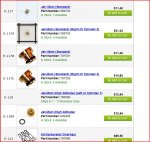Mad Mackie
Lawn Addict
- Joined
- Jul 11, 2011
- Threads
- 50
- Messages
- 1,851
Just did some research and here is what I've found.
All Intek, ELS twin cylinder engines are vertical shaft engines.
Viewing the engine from the cylinder heads/carb/intake, the left cylinder, which is closer to the flywheel, is cylinder #1.The right cylinder is #2.
As the carb is installed in a reversed position on these engines, viewing the carb from the side where the air comes into the carb, sets up the carb barrels in the opposite positions. Still viewing the carb from the incoming air side, the R/H barrel/high speed jet feeds #1 cylinder and the L/H barrel/high speed jet feeds #2 cylinder. Some Nikki carbs are marked as viewed from the incoming air side, the left is R and the right is L. This is due to the carb being installed in the reverse position.
With this in mind, the emulsion tube on the carb installs only in one position, the smaller jet is installed in the R/H hole of the emulsion tube and feeds #1 cylinder, and the L/H hole feeds #2 cylinder. Generally #1 cylinder is fed with the smaller sized jet.
The parts manual for your 446777-0316 engine is available on the B&S website and downloadable. 0316 is the type number of your engine, make sure that you find the correct type number applications in the parts manual.
You need to know the date code of your engine in order to find the correct part numbers of the jets for your engine as the jet part numbers change between date codes. Where the B&S parts manual for the Nikki carb says (Standard) (Left) (Nikki) this is the jet that feeds #1 cylinder on the engine. Similarly for the #2 cylinder.
All Intek, ELS twin cylinder engines are vertical shaft engines.
Viewing the engine from the cylinder heads/carb/intake, the left cylinder, which is closer to the flywheel, is cylinder #1.The right cylinder is #2.
As the carb is installed in a reversed position on these engines, viewing the carb from the side where the air comes into the carb, sets up the carb barrels in the opposite positions. Still viewing the carb from the incoming air side, the R/H barrel/high speed jet feeds #1 cylinder and the L/H barrel/high speed jet feeds #2 cylinder. Some Nikki carbs are marked as viewed from the incoming air side, the left is R and the right is L. This is due to the carb being installed in the reverse position.
With this in mind, the emulsion tube on the carb installs only in one position, the smaller jet is installed in the R/H hole of the emulsion tube and feeds #1 cylinder, and the L/H hole feeds #2 cylinder. Generally #1 cylinder is fed with the smaller sized jet.
The parts manual for your 446777-0316 engine is available on the B&S website and downloadable. 0316 is the type number of your engine, make sure that you find the correct type number applications in the parts manual.
You need to know the date code of your engine in order to find the correct part numbers of the jets for your engine as the jet part numbers change between date codes. Where the B&S parts manual for the Nikki carb says (Standard) (Left) (Nikki) this is the jet that feeds #1 cylinder on the engine. Similarly for the #2 cylinder.

